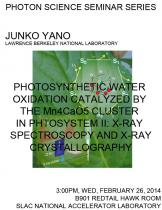Speaker: Junko Yanko, LBL
Photosynthetic water oxidation in nature has four oxidation steps operating in a cyclic fashion resulting from the successive absorption of four photons. The reaction takes place at the Mn4CaO5 cluster in the oxygen-evolving complex (OEC) of Photosystem II (PSII), a membrane-bound protein complex present in plants, algae and cyanobacteria. The OEC stores the four oxidizing equivalents, successively binds two substrate water molecules, abstracts four protons, and uses the oxidizing equivalents to oxidize water during the catalytic cycle.
We have taken two experimental approaches to study the water oxidation mechanism of the OEC under ambient condition at the LCLS; simultaneous X-ray emission spectroscopy and crystallography at CXI, and Mn L-edge absorption spectroscopy at SXR. The femtosecond X-ray pulses of the free-electron laser make it possible to outrun X-ray induced damage, allowing studies at room temperature. This is essential for following the turnover of the catalytic reaction, and the time-evolution of the photo-induced reaction can be probed using a visible laser-pump followed by the X-ray-probe pulse. We will discuss possible water oxidation mechanisms based on these results.





